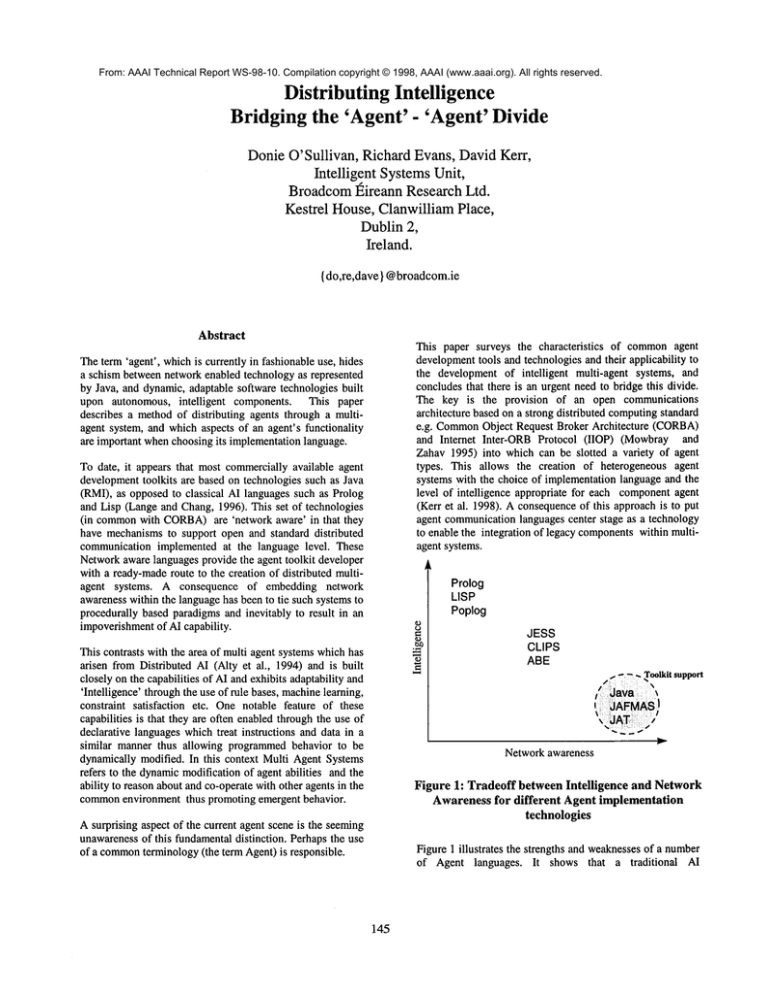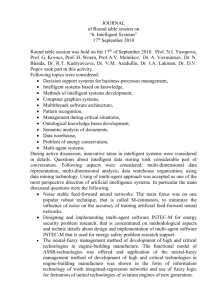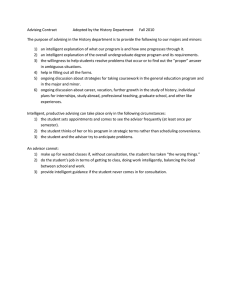
From: AAAI Technical Report WS-98-10. Compilation copyright © 1998, AAAI (www.aaai.org). All rights reserved.
Distributing Intelligence
Bridging the ’Agent’ - ’Agent’ Divide
Donie O’Sullivan, Richard Evans, David Kerr,
Intelligent Systems Unit,
Broadcomt~ireann Research Ltd.
Kestrel House, Clanwilliam Place,
Dublin 2,
Ireland.
{ do,re,dave } @broadcom.ie
Abstract
This paper surveys the characteristics
of commonagent
developmenttools and technologies and their applicability to
the development of intelligent multi-agent systems, and
concludes that there is an urgent need to bridge this divide.
The key is the provision of an open communications
architecture based on a strong distributed computingstandard
e.g. Common
Object Request Broker Architecture (CORBA)
and Internet Inter-ORB Protocol (IIOP) (Mowbray
Zahav 1995) into which can be slotted a variety of agent
types. This allows the creation of heterogeneous agent
systems with the choice of implementation language and the
level of intelligence appropriate for each componentagent
(Kerr et al. 1998). A consequenceof this approach is to put
agent communicationlanguages center stage as a technology
to enable the integration of legacy componentswithin multiagent systems.
Theterm ’agent’, whichis currently in fashionable use, hides
a schism between network enabled technology as represented
by Java, and dynamic, adaptable software technologies built
upon autonomous, intelligent
components. This paper
describes a methodof distributing agents through a multiagent system, and whichaspects of an agent’s functionality
are important whenchoosing its implementation language.
To date, it appears that most commercially available agent
developmenttoolkits are based on technologies such as Java
(RMI), as opposed to classical AI languages such as Prolog
and Lisp (Lange and Chang, 1996). This set of technologies
(in commonwith CORBA)
are ’network aware’ in that they
have mechanismsto support open and standard distributed
communication implemented at the language level. These
Networkaware languages provide the agent toolkit developer
with a ready-maderoute to the creation of distributed multiagent systems. A consequence of embedding network
awarenesswithin the language has been to tie such systems to
procedurally based paradigms and inevitably to result in an
impoverishmentof AI capability.
Prolog
LISP
Poplog
JESS
CLIPS
ABE
This contrasts with the area of multi agent systems whichhas
arisen from Distributed AI (Alty et al., 1994) and is built
closely on the capabilities of AI and exhibits adaptability and
’Intelligence’ throughthe use of rule bases, machinelearning,
constraint satisfaction etc. One notable feature of these
capabilities is that they are often enabled through the use of
declarative languages which treat instructions and data in a
similar manner thus allowing programmedbehavior to be
dynamically modified. In this context Multi Agent Systems
refers to the dynamicmodification of agent abilities and the
ability to reason about and co-operate with other agents in the
commonenvironment thus promoting emergent behavior.
.~ --
~ Toolkit
support
i i~ava
i ’JAFMAS!
Network awareness
Figure 1: Tradeoff between Intelligence
and Network
Awareness for different Agent implementation
technologies
A surprising aspect of the current agent scene is the seeming
unawarenessof this fundamental distinction. Perhaps the use
of a common
terminology (the term Agent) is responsible.
Figure 1 illustrates the strengths and weaknessesof a number
of Agent languages. It shows that a traditional
AI
145
implementation language such as Prolog is strong for
implementing
an Intelligent Agent,but weakat distributing
that agent throughouta network,whereasa languagesuch as
Javais strong at achievingdistribution, but a weakchoicefor
the development
of an Intelligent Agent.
Several key facets of these agent types govern the
implementation
selection process. Firstly the Userprofiling
agentrequiresadaptivity,potentiallylearning, andthe ability
to provide recommendationsto the user. The choice of
languageshould therefore easily allow for these traits,
therefore, a suitable languagewouldbe declarative (e.g.
Prolog or LISP). Thechoice of implementationlanguagefor
the legacy database agent should be governedby the API
whichthe legacy database provides to external programs.
Thereis no ’intelligence’ necessary, therefore, a suitable
languagecould be Java or C++.Finally the travel booking
agentwill not necessarilyrequireintelligence,but will require
the ability to communicate
withother multi-agentsystems,so
support for a protocol such as IIOP, in addition to a
procedurallanguagewill be suitable.
This paperalso describesworkundertakenby the authors and
others towards the realization of a platform for the
developmentof multi-agent systems, with heterogeneous
agent behaviors and characteristics (various levels of
’intelligence’) within an opencommunications
architecture.
Specifically wedescribe the AgentServicesLayer(Somerset
al. 1997), whichis an agent development
platform, built on
top of CORBA,
which supports the developmentof multiagent systems,composed
of heterogeneousagents, i.e. agents
developedfor specific purposesin languagestailored to that
purpose. To date there is support for the developmentof
agents in a numberof languages including Prolog, CLIPS,
JESS,C / C++and Java.
The FIPAstandard for Agent Management
(Chiariglione et
al. 1997) presents an opportunity to achieve the desired
result as it mandates
the use of the Inter-ORB
Interoperability
Protocol(IIOP)as the baseline1 for interoperability between
different agent systems. The need to develop Intelligent
Agents which exploit the FIPA Agent Communication
Language(ACL)in a sophisticated way and which comply
with the FIPAstandard for agent management
should act as a
key motivation for integrating suitable Intelligent Agent
developmenttechnologies within an open communications
architecture,in this caseIIOP.
Thechoice of implementation
languageis often least thought
about whenimplementing
an agent system. Achoice is either
not available to the programmer
(in the case wherethe multiagent systemdoesnot use any sort of middleware)
or else the
programmer’s
habits or current trends dictate the language.A
moreideal scenario is wherethere is no constraint on the
implementationlanguage, and each agent in a multi-agent
systemin analysedat designtime, to determinethe servicesit
is to provide to the multi-agentsystem.This analysis will
lead to some indication of appropriate implementation
language(albeit declarativeversusprocedural).
The ability to choose the appropriate implementation
language for each agent allows the agent programmerto
developthe agent in such a mannerthat its characteristics
closely matchthose of the chosenlanguage.This ability is
largely a function of the platform within whichthe agents
reside and therefore the agent platformis possibly the key
decisionthe developerof a multi-agentsystemshouldmake.
References
Lange, D. B. and Chang, D. T. 1996. IBM Aglets
Workbench, ProgrammingMobile Agents in Java, A White
Paper. International Business MachinesInc.
Alty J. L. et al., 1994. ADEPT- Advanced Decision
Environment for Process Tasks: Overview and
Architecture, Internal Report, QMW
College London.
Mowbray, T. J. and Zahavi, R. 1995. The Essential
CORBA:
Systems Integration Using Distributed Objects,
Framingham, Mass.: Object ManagementGroup.
As an example,consideran application (Chiariglioneet al.
1997b)wherethe following agents have been identified as
forming the backboneof the multi-agent system. (i) User
profiling agent (ii) Legacydatabaseagent (iii) travel booking
agent. Oneof the first tasks in the implementation
of such a
system(after selection of an appropriateagent architecture,
whichis platformand languageindependent)is to select the
implementationlanguagefor each of these agents. The User
profilingagenthas to handleadaptivity(to profile the user)
well as storing user profiles. Thelegacy database agent is
responsiblefor providingaccess to an external data through
the use of the ACL.Thetravel bookingagent is responsible
for communicating
bookingrequests to the appropriatetravel
bookingplatform(whichis not underthe developerscontrol).
1 This does not preclude the use of other interoperability
protocols, it simply meansthat IIOP must be supported.
146
Kerr, D.; O’Sullivan, D.; Evans, R.; Richardson, R. and
Somers, F. 1998. Experiences using Intelligent Agent
Technologies as a Unifying Approach to Network and
Service Management, In Proceedings of IS&N ’98,
Antwerp, Belgium.
Somers,F.; Evans, R.; Kerr, D. and O’Sullivan, D. 1997.
Scalable Low-Latency Network ManagementUsing
Intelligent Agents, in Proceedingsof ISS ’97, Toronto,
Canada.
Chiariglione L. et al. 1997. FIPA97 Specification Part 1:
Agent Management.Turin, Italy: Foundationfor Intelligent
Physical Agents.
Chiariglione L. et al. 1997b. FIPA97 Specification Part 4:
Personal Travel Assistance. Turin, Italy: Foundation for
Intelligent Physical Agents.








